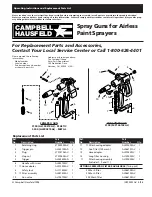
P
PR
RE
ES
SS
SU
UR
RE
E F
FE
EE
ED
D C
CIIR
RC
CU
UL
LA
AT
TIIN
NG
G H
HO
OO
OK
KU
UP
P
For heavy production spraying, air pressure for atomiza-
tion is controlled by the regulator on the air source. The
fluid pressure is regulated by a separate fluid regulator
at the bulk paint source.
G
GR
RA
AV
VIIT
TY
Y F
FE
EE
ED
D C
CU
UP
P H
HO
OO
OK
KU
UP
P
This popular method is similar to the siphon feed with cup
except that the paint cup is mounted above the spray gun.
This creates a positive fluid pressure in the fluid nozzle while
providing better balance and comfort for the operator.
ASSEMBLY
A
Allll p
pa
arrtts
s o
on
n a
a s
sp
prra
ay
y g
gu
un
n s
sh
ho
ou
ulld
d b
be
e s
sc
crre
ew
we
ed
d iin
n h
ha
an
nd
d ttiig
gh
htt a
att
ffiirrs
stt; this will avoid the possibility of cross threading the
parts. If the parts can not be turned by hand easily, make sure you have the correct
parts, unscrew by hand easily, make sure you have the correct parts, unscrew,
realign, and try again. NEVER use undue force in mating parts.
1) Connect the paint cup to the fluid inlet nipple and tighten to ensure a good seal,
using spanner. Use of the supplied filter screen is optional. This filter helps protect
against small particle contaminants. See parts drawing for proper filter placement.
2) Wrap the threads on the air inlet nipples of
the spray gun and the regulator with a
couple of layers of PTFE tape to help
prevent air leaks.
3) Connect the regulator to the air inlet nipple
at the base of the gun handle.
4) Connect the air supply to the air inlet
nipple on the regulator.
8
9
Filtered,
regulated
air source
Fluid
Fluid Regulator
Air
Filtered
air source
PTFE Tape
Air Source
In order to qualify as an HVLP spray gun, dynamic air pressure, when measured at
the air cap, must not exceed 10 PSI. HVLP Spray guns produce a soft, low velocity
spray pattern which provides increased control while reducing paint “bounce-back”
and overspray. As a result, HVLP is also well suited for spraying surfaces with
recessed areas.
TYPES OF SPRAY GUN HOOKUPS
S
SIIP
PH
HO
ON
N F
FE
EE
ED
D C
CU
UP
P H
HO
OO
OK
KU
UP
P
Air pressure for atomization is controlled by the regulator
on the air source. The amount of fluid is adjusted by the
fluid control knob on the gun, the paint viscosity, and the
air pressure. The siphon cup must be vented to the
atmosphere.
P
PR
RE
ES
SS
SU
UR
RE
E F
FE
EE
ED
D C
CU
UP
P H
HO
OO
OK
KU
UP
P
Air pressure for atomization is controlled by the regu-
lator on the air source. The fluid pressure is set by
adjusting the cup regulator. The amount of fluid is also
adjusted by the fluid control knob. This method is
required for heavy fluids and when using internal mix
nozzle spraying. This method generally requires a spe-
cial fluid tip, needle and air cap set.
P
PR
RE
ES
SS
SU
UR
RE
E F
FE
EE
ED
D T
TA
AN
NK
K H
HO
OO
OK
KU
UP
P
This method is similar to the pressure feed cup hookup
with the added benefit of being able to orient the gun in
any position independent of the tank. This method is
useful for medium production or large scale spraying
applications where large quantities of paint are used.
For medium production spraying (single regulator setup
on tank), air pressure for atomization is controlled by
the regulator at the air source. The amount of fluid is
adjusted by the regulator on the paint pressure tank.
For portable painting operations (double regulator setup
on tank), air pressure for atomization and fluid supply is
regulated by two individual air regulators on the paint
pressure tank.
Filtered,
regulated
air source
Fluid
control
knob
Filtered,
regulated
air source
Fluid
control
knob
Fluid pressure
regulator
Cup pressure hose
Filtered,
regulated
air source
Pressure Tank
Fluid Outlet
Air
Air
Filtered,
regulated
air source
Pressure Tank
Fluid
Air
Air
Summary of Contents for HVLP
Page 1: ...1 HVLP Spray Guns Instruction Manual ...
Page 12: ...23 NOTES NOTES 22 ...































